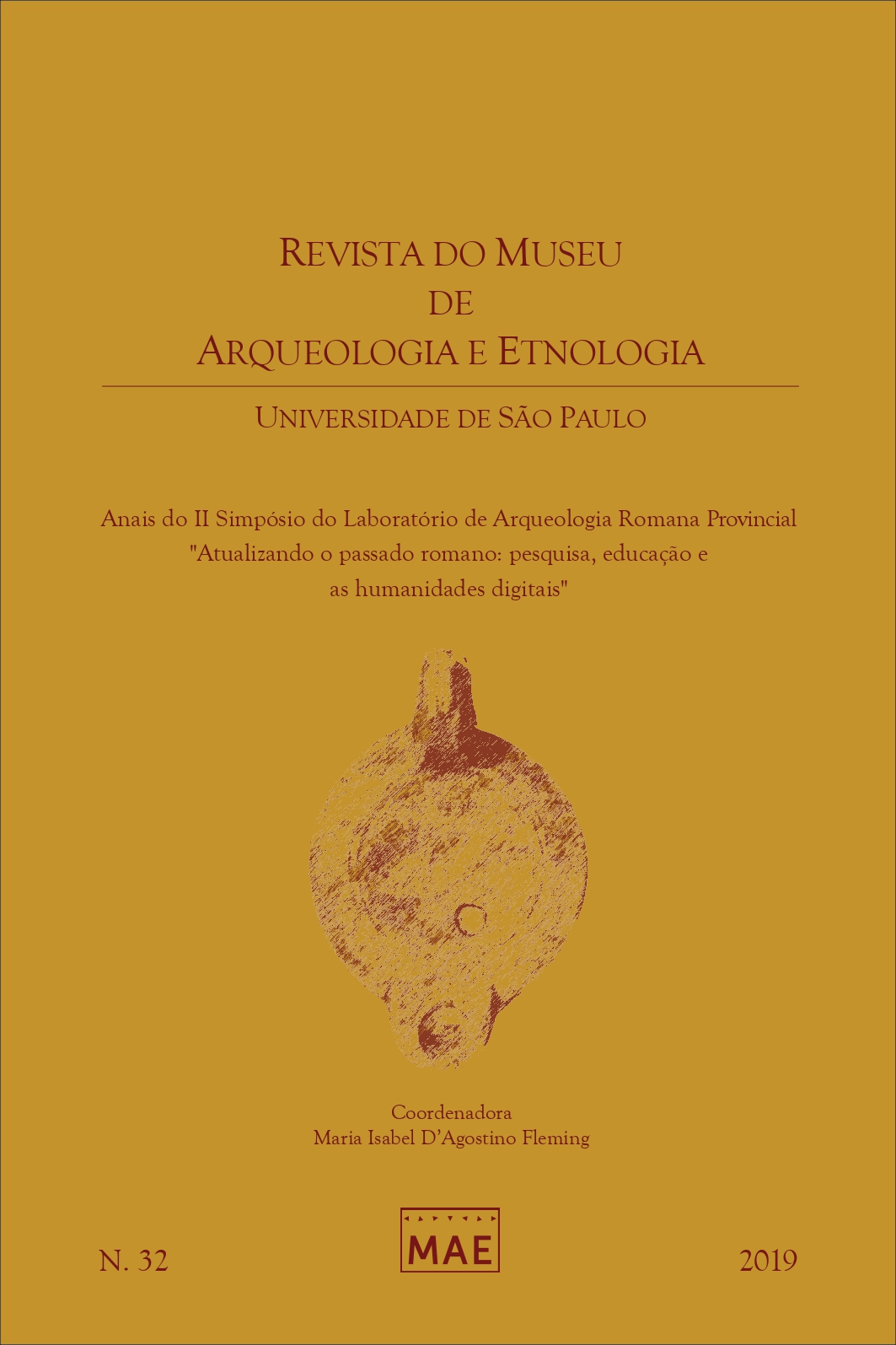Os desafios do passado a um toque
DOI:
https://doi.org/10.11606/issn.2448-1750.revmae.2019.164177Palavras-chave:
Humanidades digitais, Tecnologia, História, Arqueologia, AntiguidadeResumo
O artigo trata dos desafios da digitalização das informações sobre o passado. Inicia-se com a apresentação de uma longa tradição de transmissão material e analógica das informações, desde a Antiguidade, tradição textual, imprensa, até a revolução informática e numérica. Apresentam-se, a seguir, as mudanças das últimas décadas no armazenamento e transmissão de informações, assim como crescente importância da realidade virtual no geral, e no que se refere à apresentação e tratamento do passado. No caso específico do mundo romano, multiplicaram-se os bancos de dados, tanto da tradição textual, como da imensa materialidade (inscrições, imagens, artefatos, construções e muito mais). Isso significa um acesso muito mais amplo e generalizado ao mundo romano. Outro aspecto refere-se à recriação virtual, que se amplia cada vez mais, tanto no meio acadêmico, como de divulgação. Isso gera questões epistemológicas pouco óbvias a respeito da diversidade interpretativa, na medida em que a ampliação das possibilidades construtivas virtuais leva à multiplicação de questionamentos sobre os modelos e pressupostos interpretativos. Talvez esse seja o maior desafio das novas tecnologias.
Downloads
Referências
Berry, D. M. 2011. The computational turn: thinking about the digital humanities. Culture Machine, v. 12: 01-22.
Berry, D. M. 2014. Post-digital humanities: computation and cultural critique in the arts and humanities. Educause. Vol. 49, n. 3: 22-26.
Boëda, E; Geneste, J.-M.; Meignen, L. 1990. Identification de chaînes opératoires du Paléolithique ancien et moyen. Paléo, n. 02: 43-88.
Carlan, C.U; Funari, P. P. A.; Funari, R. S. (Orgs.) 2015. O cinema e o Mundo Antigo. Novas Edições Acadêmicas, São Paulo.
Chevitarese, A. L. 2013. Jesus no Cinema. um balanço histórico e cinematográfico entre 1905 e 1927. Kliné Editora, Rio de Janeiro.
Childe, V.G. 1942. What Happened in History. Penguin Books Ltd., Harmondsworth and New York.
Claval, P. 2014. História da Geografia. Edições 70, Lisboa.
Collingwood, R. 1946. The idea of history. Oxford University Press, Oxford.
Durant, W. (1935/1975) The story of civilization. Simon & Schuster, Nova Iorque.
Earl, G. (et al.) 2016. Formal and Informal Analysis of Rendered Space: The Basilica Portuense. In: Bevan, A; Lake, M. (Eds.) Computional approaches to archaeological space. Routledge, London: 265-284.
Ferraro, A. R. 2011. A trajetória das taxas de alfabetização no Brasil nas décadas de 1990 e 2000. Educ. Soc. (Online). vol.32, n.117: 989-1013.
Field, A. 2016. An Automated Approach to Syntax-based Analysis of Classical Latin. Disponível em: https://journals.ub.uniheidelberg.de/index.php/dco/article/view/32315. Acessado em: 16/04/2018.
Fleming, M. I.D; Teixeira-Bastos, M; Porto, V. C. 2017. Arqueologia Clássica e as Humanidades Digitais no Brasil. Cadernos do Lepaarq. (Universidade Federal de Pelotas). v.14. n.27: 10-28.
Foucault, M. 1971. L'Ordre du discours. Gallimard, Paris.
Funari, P. P. A. 2005. Repensando o mundo antigo. Volume I. Textos de: Jean Pierre Vernant e Richard Hingley. In: Textos Didáticos. Publicações do IFCH/Unicamp. v. 47: 1-70.
Funari, P. P. A. 2013. Aspectos da gestão de acervos em bibliotecas na era digital. Mimesis. (Bauru), v. 28: 23-38.
Funari, P. P. A. 2006. Gestão, preservação e acesso a documentos digitais: patrimônio cultural e diversidade. Cadernos do CEOM (UNOESC). v.18. n.22: 213-229.
Funari, P. P. A.; Poloni, R. J. S. 2014. Arqueologia Urbana: trajetória e perspectivas. Revista do Arquivo Municipal (São Paulo), v. 205: 137-154.
Mcmullen, R. 1982. The Epigraphic Habit in the Roman Empire. The American Journal of Philology. Vol. 103, n. 3: 233-246.
Murtonen, A. 1989. Hebrew in its western Semitic setting. Brill, Leiden.
Goody, J. 1986. The Logic of Writing and the Organisation of Society. Cambridge University Press, Cambridge.
Habermas, J. 1968. Technik und Wissenschaft als Ideologie. Suhrkamp, Frankfurt.
Isaac, G. 1978. The Food Sharing Behavior of Protohuman Hominids. Scientific American. v.238, n.4: 90-108.
Ko, K. H. 2016. Origins of human intelligence: The chain of tool-making and brain evolution. Anthropological Notebooks. v.22, n.1: 5-22.
Leroi-Gourhan, A. 1965. Le Geste et la parole. (Vol.1: Technique et langage; v.2: La mémoire et les rythmes). Ed. Albin Michel, Paris.
Machado, M. 2018. A teoria da antropologia digital para as humanidades digitais. Revista Z Cultural. UFRJ. v. 02. s/p.
Moorehead, J. D. 1995. Compromising the Hearsay Rule: The Fallacy of Res Gestae Reliability. Loyola of Los Angeles Law Review. V.29 (Nov.): 203-246.
Nora, P. 1984. Les Lieux de mémoire. Gallimard, Paris.
Nygren, T; Foka, A; Buckland, P. 2014. The Status Quo of Digital Humanities in Sweden: Past, Present and Future of Digital History. H-Soz-Kult. Disponível em: www.hsozkult.de/debate/id/diskussionen-2402.
Patterson, E. E. 2015. Oral Transmission: A Marriage of Music, Language, Tradition, and Culture. Musical Offerings. vol.6, n. 1, Article 2: 35-47.
Pelegrin, J. 2004. Sur le milieu intérieur d’André Leroi-Gourhan et l’analyse de la taille de pierre au Paléolithique. In: Audouze, F; Schlanger, N. (Eds.) Autour de l’homme: contexte et actualité d’André Leroi-Gourhan. Editions APDCA: Antibes: 149-162.
Pinto, R. 2017. Uma morte muito exagerada: Robin G. Collingwood e a 'romanização' da Bretanha Romana. Revista Heródoto. Unifesp. v. 2: 522-543.
Popper, K. 1992. In search of a better world. Routledge, London.
Rosenberg, B.A. 1987. The Complexity of Oral Tradition. Oral Tradition. 2/1: 73-90.
Rostovtzeff, M. 1926. A History of the Ancient World: v. I. The Orient and Greece. Oxford: Clarendon Press.
Rostovtzeff, M. 1927. History of the Ancient World: v. II. Rome. Oxford: Clarendon Press.
Rubin, V. L.; Vashchilko, T. 2012. Extending information quality assessment methodology: A new veracity/deception dimension and its measures. Proc. Am. Soc. Inf. Sci. Technol. vol. 49, no. 1: 1-6.
Rubio-Campillo, X.; Montanier, J. M.; Rull, G.; Bermúdez L. J. M; Moros Díaz, J.; Pérez González, J.; Remesal Rodríguez, J. 2018. The ecology of Roman trade. Reconstructing provincial connectivity with similarity measures. Journal of Archaeological Science. v. 92: 37-47.
Schmidt, S. 2018. AI-based fake videos pose the latest threat to what we perceive as reality — and possibly our democracy. Disponível em: https://www.pri.org/stories/2018-03-18/ai-based-fake-videos-pose-latest-threat-what-we-perceive-reality-and-possibly-our. Acessado em: 16/04/2018.
Semaw, S.; Rogers, M. J.; Quade, J.; Renne, P. R.; Butler, R. F.; Dominguez-Rodrigo, M.; Stout, D.; Hart, W. S.; Pickering, T.; Simpson, S. W. 2003. 2.6-Million-year-old stone tools and associated bones from OGS-6 and OGS-7, Gona, Afar, Ethiopia. J. Hum Evol. v.45 (2): 169-177.
Silberman, N. 2016. Discovering Authenticity, Getting to the heart of places that matter. Disponível em: http://www.coherit.com/blog/author/neil/.
Von Ranke, L. 1834-1836. Die römischen Päpste in den letzten vier Jahrhunderten.White, H. 1978. Tropics of Discourse: Essays in Cultural Criticism. The Johns Hopkins University Press, Baltimore.
Downloads
Publicado
Edição
Seção
Licença
Copyright (c) 2019 Pedro Paulo A. Funari

Este trabalho está licenciado sob uma licença Creative Commons Attribution-NonCommercial-NoDerivatives 4.0 International License.


















